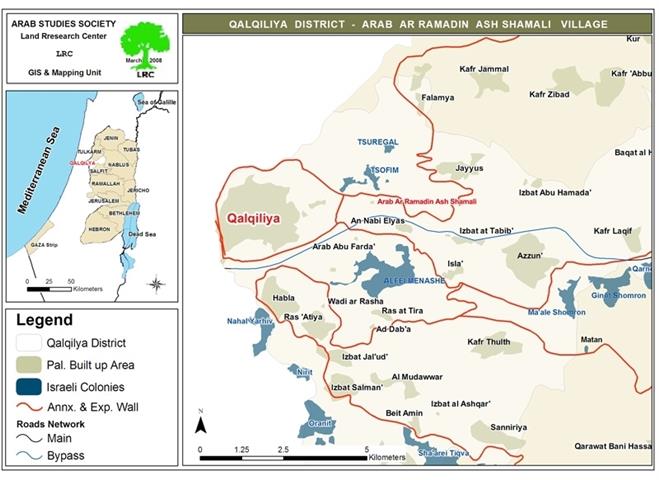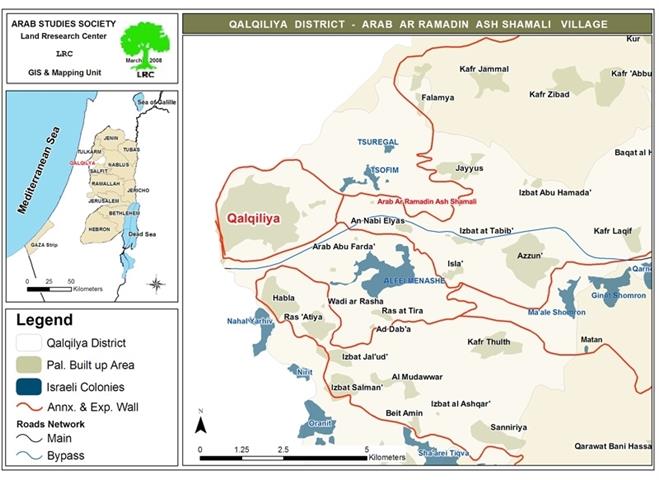Violation: Issuing stop-work orders against a number of structures besides offering the opportunity to object to previous demolition orders.
Location: ‘Arab ar Ramadin ash Shamali.
Violators: the Construction and Organization Committee in the Israeli Occupation Government.
Victims: ‘Arab ar Ramadin ash Shamaliresidents.
Details:
The Construction and Organization Committee handed on February 2, 2010 six stop-work and demolition orders to residents of ‘Arab ar Ramadin ash Shamali to the north east of Qalqiliya City.
Picture 1: part of the threatened structures
The delivered notifications included chances to object to previous demolition orders. These were given a chance till the March 3, 2009 to show their cases. Furthermore, two stop-work orders were issued against houses on their construction phase. Also, the owners were given till March 3, 2010 to object to the orders and continue the permit issuing procedures. It must be known that the Israeli Occupation Authorities do not grant construction permits in areas classified ‘C’ according to Oslo Agreement.
Table 1: owners of the threatened properties:
|
No.
|
Victim
|
Number of structures
|
Area (m2)
|
Family members
|
Number of children
|
Type of structure
|
Order type
|
Previous notification
|
|
1
|
Khaled al Jakharma
|
1
|
12
|
9
|
6
|
residential
|
Another objection chance
|
2/8/2004
|
|
2
|
Abdullah al Jakharma
|
1
|
40
|
7
|
5
|
Residential
|
Another objection chance
|
1/10/2005
|
|
3
|
Solomon al Jakharma
|
1
|
24
|
11
|
8
|
Residential
|
Another objection chance
|
2/8/2004
|
|
4
|
Moh’d al Jakharma
|
1
|
36
|
8
|
4
|
Residential
|
Another objection chance
|
26/10/2006
|
|
5
|
Noman al Jakharma
|
1
|
10
|
8
|
6
|
Barn
|
Stop-work
|
|
|
6
|
‘Ammar al Jakharma
|
1
|
40
|
1
|
0
|
Residential (under construction)
|
Stop-work
|
|
|
Total
|
6
|
162
|
44
|
29
|
|
|
|
It must be pointed that the simple residential and agricultural structures in ‘Arab ar Ramadin ash Shamali are facing similar harassments since 2000. 27 families and 40 structures exist in the area. All of the structures had previously received stop-work or demolition orders.
Sheikh Qadir Jakharma, the leader of Al Ramadin in the area stated to an LRC observer:’ we have been living in these parts since 1966, even before the Israeli Occupation. We leased this land from villagers in Jayyus and and Qalqiliya City. We have not seen a good day since 1967, since these parts were occupied. There are daily aggressions on shepherds, extreme movement restrictions, in addition to destroying or notifying the structures of demolition.
The Israeli Occupation is trying to disperse us using any mean necessary. We are now obliged to get construction permits which is not possible since the Israeli Occupation Authorities do not issue construction permits in areas classified ‘C’ according to Oslo.
Moreover, the Israeli Authorities consider the lease contract that we have illegal and consider the land we are using is the property of immigrants and that we are not allowed to use. However, no matter how many obstacles the Israeli will put in our way, we will always stay in our land and never leave’.
‘Arab ar Ramadin ash Shamali:
‘Arab ar Ramadin ash Shamali pool is located to the north east of Qalqiliya City and behind the segregation wall. It is located 700 meters away from Tzufin colony which is built on Jayyus lands. Moreover, there is a nearby Israeli Army encampment. The threatened structures are very simple ones, built out of metal slabs or wood and some of them are nothing more than tents that shelter more than 81 people.
Picture 2: ‘Arab ar Ramadin ash Shamali pool
It should be pointed that ‘Arab ar Ramadin are nomads who immigrated from Beer al Saba’ (Be’er Sheva) area in 1950. They were promised to be brought back to their homes in an agreement made with the Israelis under the UN supervision. Of course, the Israelis retreated from their commitments and refused to allow them back. Ar Ramadin were divided into two sections, part of them settled north, near Qalqiliya and the other part settled south, near Hebron. Since 1950, the southern Ramadin bought lands and settled there; they have been living in their village ever since.

















